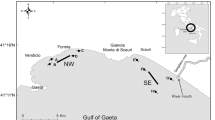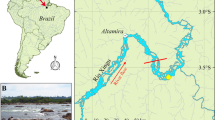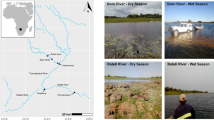Abstract
This study examines the temporal and spatial variability of the floodplain trophic contribution to the fish community of Lake Saint-Pierre, a large (≈ 300 km2), shallow (≈ 3 m) widening of the St. Lawrence River (Québec, Canada). We hypothesized that floodplain contribution to fish diet would be maximal during the early growing period following the seasonal flood and at sites located closest to the floodplain. Carbon stable isotope ratios (δ13C) of invertebrates and 35 fish species were analyzed at the beginning and at the end of two growing seasons, at increasing distances from the floodplain. Floodplain contribution, in the form of exported aquatic invertebrates, was estimated at the fish community (littoral versus main river), species and individual fish level, using a stable isotopic mixing model and a linear mixed model selection. As hypothesized, fish captured in the early part of the growing season near the floodplain benefitted from the largest floodplain contribution, which decreased during the late growing season. In addition, floodplain contribution differed among fish species, being higher in small or immature littoral species (northern pike, yellow perch, blackchin and golden shiners) than for larger taxa inhabiting the main river channel (shorthead redhorse, white sucker and channel catfish). Our study revealed that floodplain production during the early growing season represents a key food resource to a large portion of the riverine food web, thus highlighting the essential role of the floodplain in human-altered temperate rivers.






Similar content being viewed by others
References
ACIA (Arctic Climate Impact Assessment). 2004. Impacts of a warming Arctic: Arctic climate impact assessment. Oxford, UK: Cambridge University Press.
Barth JAC, Veizer J. 1999. Carbon cycle in St. Lawrence aquatic ecosystems at Cornwall (Ontario), Canada: seasonal and spatial variations. Chem Geol 159:107–28.
Bayley PB. 1995. Understanding large river: floodplain ecosystems. BioScience 45:153–8.
Bertrand M, Cabana G, Marcogliese DJ, Magnan P. 2011. Estimating the feeding range of a mobile consumer in a river-flood plain system using δ13C gradients and parasites. J Anim Ecol 80:1313–23.
Bivand RS, Wong DWS. 2018. Comparing implementations of global and local indicators of spatial association. TEST 27:716–48.
Bunn SE, Boon PI. 1993. What sources of organic carbon drive food webs in billabongs? A study based on stable isotope analysis. Oecologia 96:85–94.
Burn DH, Whitfield PH. 2016. Changes in floods and flood regimes in Canada. Can Water Resour J 41:139–50.
Burnham KP, Anderson DR. 1998. Introduction in: Model selection and inference: Springer.
Burnham KP, Anderson DR. 2002. Model selection and multimodel inference: a practical information-theoretic approach. Berlin: Springer.
Busst GMA, Britton JR. 2018. Tissue-specific turnover rates of the nitrogen stable isotope as functions of time and growth in a cyprinid fish. Hydrobiologia 805:49–60.
Casper AF, Thorp JH. 2007. Diel and lateral patterns of zooplankton distribution in the St. Lawrence River. River Res Applic 23:73–85.
Carleton SA, Martínez del Rio C. 2005. The effect of cold-induced increased metabolic rate on the rate of 13C and 15N incorporation in house sparrows (Passer domesticus). Oecologia 144:226–32.
Delong MD, Thorp JH. 2006. Significance of instream autotrophs in trophic dynamics of the Upper Mississippi River. Oecologia 147:76–85.
DeNiro MJ, Epstein S. 1978. Influence of diet on the distribution of carbon isotopes in animals. Geochim Cosmochim Acta 42:495–506.
Dettmers JM, Wahl DH, Soluk DA, Gutreuter S. 2001. Life in the fast lane: fish and foodweb structure in the main channel of large rivers. J North Am Benthol Soc 20:255–65.
Fernandes CC. 1997. Lateral migration of fishes in Amazon floodplains. Ecol Freshw Fish 6:36–44.
Finlay JC. 2001. Stable carbon isotope ratios of river biota: implications for energy flow in lotic food webs. Ecology 82:1052–64.
Forsberg BR, Araujo-Lima CARM, Martinelli LA, Victoria RL, Bonassi JA. 1993. Autotrophic carbon sources for fish of the central Amazon. Ecology 74:643–52.
Frenette JJ, Arts MT, Morin J. 2003. Spectral gradients of downwelling light in a fluvial lake (Lake Saint-Pierre, St-Lawrence River). Aquat Ecol 37:77–85.
Górski K, Winter HV, De Leeuw JJ, Minin AE, Nagelkerke LAJ. 2010. Fish spawning in a large temperate floodplain: the role of flooding and temperature. Freshw Biol 55:1509–19.
Górski K, Collier KJ, Duggan IC, Taylor CM, Hamilton DP. 2013. Connectivity and complexity of floodplain habitats govern zooplankton dynamics in a large temperate river system. Freshw Biol 58:1458–70.
Górski K, De Leeuw JJ, Winter HV, Khoruzhaya VV, Boldyrev VS, Vekhov DA, Nagelkerke LAJ. 2016. The importance of flooded terrestrial habitats for larval fish in a semi-natural large floodplain (Volga, Russian Federation). Inland Waters 6:105–10.
Gutreuter S, Bartels AD, Irons K, Sandheinrich MB. 1999. Evaluation of the flood-pulse concept based on statistical models of growth of selected fishes of the Upper Mississippi River system. Can J Fish Aquat Sci 56:2282–91.
Herwig BR, Wahl DH, Dettmers JM, Soluk DA. 2007. Spatial and temporal patterns in the food web structure of a large floodplain river assessed using stable isotopes. Can J Fish Aquat Sci 64:495–508.
Hesslein RH, Hallard KA, Ramlal P. 1993. Replacement of sulfur, carbon, and nitrogen in tissues of growing broad whitefish (Coregonus nasus) in response to a change in diet traced by δ34S, δ13C, and δ15N. Can J Fish Aquat Sci 50:2071–6.
Hladyz S, Nielsen DL, Suter PJ, Krull ES. 2012. Temporal variations in organic carbon utilization by consumers in a lowland river. River Res Applic 28:513–28.
Hobson KA. 1999. Tracing the origins and migration of wildlife using stable isotopes: a review. Oecologia 120:314–26.
Hudon C, Gagnon P, Rondeau M, Hébert S, Gilbert D, Hill B, Patoine M, Starr M. 2017. Hydrological and biological processes modulate carbon, nitrogen, and phosphorus flux from the St. Lawrence River to its estuary (Québec, Canada). Biogeochemistry 135:251–76.
Hudon C, Jean M, Létourneau G. 2018. Temporal (1970-2016) changes in human pressures and wetland response in the St. Lawrence River (Québec, Canada). Sci Total Environ 643:1137–51.
Humphries P, Keckeis H, Finlayson B. 2014. The river wave concept: integrating river ecosystem models. BioScience 64:870–82.
Huryn AD, Riley RH, Young RG, Arbuckle CJ, Peacock K, Lyon G. 2001. Temporal shift in contribution of terrestrial organic matter to consumer production in a grassland river. Freshw Biol 46:213–26.
Jackson AL, Inger R, Parnell AC, Bearhop S. 2011. Comparing isotopic niche widths among and within communities: SIBER- Stable Isotope Bayesian Ellipses in R. J Anim Ecol 80:595–602.
Jardine TD, Gray MA, McWilliam SM, Cunjak RA. 2005. Stable isotope variability in tissues of temperate stream fishes. Trans Am Fish Soc 134:1103–10.
Jobling M. 1983. Growth studies with fish: overcoming the problems of size variation. J. Fish Biol 22:153–7.
Jones RI, Grey J. 2011. Biogenic methane in freshwater food webs. Freshw Biol 56:213–29.
Junk WJ, Bayley PB, Sparks RE. 1989. The flood pulse concept in river-floodplain systems. Can J Fish Aquat Sci Spec Publ 106:110–27.
Junk WJ, Robertson BA (1997) Aquatic invertebrates. In: Junk WJ (ed) The Central Amazon floodplain, ecology of a pulsing system, vol 126. Berlin, Springer-Verlag.
Keough JR, Sierszen ME, Hagley CA. 1996. Analysis of a Lake Superior coastal food web with stable isotope techniques. Limnol Oceanogr 41:136–46.
Keough JR, Hagley CA, Ruzycki E, Sierszen M. 1998. δ13C composition of primary producers and role of detritus in a freshwater coastal ecosystem. Limnol Oceanogr 43:734–40.
Kiljunen M, Grey J, Sinisalo T, Harrod C, Immonen H, Jones RI. 2006. A revised model for lipid-normalizing δ13C values from aquatic organisms, with implications for isotope mixing models. J Appl Ecol 43:1213–22.
Kirjasniemi M, Valtonen T. 1997. Size-dependent over-winter mortality of young-of-the-year roach, Rutilus rutilus. 1997. Environ Biol Fishes 50:451–6.
Kirk JTO. 1985. Effects of suspensoids (turbidity) on penetration of solar radiation in aquatic ecosystems. Hydrobiologia 125:195–208.
Latli A, Sturaro N, Desjardin N, Michel LN, Otjacques W, Lepoint G, Kestemont P. 2017. Isotopic half-life and enrichment factor in two species of European freshwater fish larvae: an experimental approach. Rapid Commun Mass Spectrom 31:685–92.
Lessard M. 1991. Analyse multidimensionnelle et discontinuités spatiales des communautés de poissons du lac Saint-Pierre et de l’archipel de Sorel. Thesis: Université du Québec à Montréal, Montréal.
Luz-Agostinho KDG, Agostinho AA, Gomes LC, Júlio HF Jr. 2008. Influence of flood pulses on diet composition and trophic relationships among piscivorous fish in the upper Paraná River floodplain. Hydrobiologia 607:187–98.
MacAvoy SE, Macko SA, Garman GC. 2001. Isotopic turnover in aquatic predators: quantifying the exploitation of migratory prey. Can J Fish Aquat Sci 58:923–32.
Nakano S, Murakami M. 2001. Reciprocal subsidies: dynamic interdependence between terrestrial and aquatic food webs. PNAS 98:166–70.
Paris A, Cabana Frenette JJ. 2016. Highly variable benthic-pelagic coupling in a large fluvial lake revealed by carbon isotopes. Life Env 66:287–95.
Parnell AC, Inger R, Bearhop S, Jackson AL. 2008. SIAR: stable isotope analysis in R. http://cran.r-project.org/web/packages/siar/index.html.
Parnell AC, Inger R, Bearhop S, Jackson AL. 2010. Source partitioning using stable isotopes: coping with too much variation. PLoS ONE 5:e9672.
Polis GA, Anderson WB, Holt RD. 1997. Toward an integration of landscape and food web ecology: the dynamics of spatially subsidized food webs. Annu Rev Ecol Syst 28:289–316.
Post DM, Layman CA, Arrington DA, Takimoto G, Quattrochi J, Montaña CG. 2007. Getting to the fat of the matter: models, methods, and assumptions for dealing with lipids in stable isotope analysis. Oecologia 152:179–89.
R Development Core Team. 2017. R: a language and environment for statistical computing. R Foundation for Statistical Computing Vienna, Austria: http://www.R-project.org.
Reckendorfer W, Keckeis H, Winkler G, Schiemer F. 1999. Zooplankton abundance in the River Danube, Austria: the significance of inshore retention. Freshw Biol 41:583–91.
Roach KA. 2013. Environmental factors affecting incorporation of terrestrial material into large river food webs. Freshw Sci 32:283–98.
Rooney N, McCann K, Gellner G, Moore JC. 2006. Structural asymmetry and the stability of diverse food webs. Nature 442:265–9.
Savignac R. 1985. Détermination de l’abondance du zooplankton dans le lac St- Pierre pour la période de crue printanière de 1984. Rapport d’étude, N/Réf. Réquisition 038766. Gouvernement du Québec, Ministère du Loisir, de la Chasse et de la Pêche.
Schramm HL Jr, Eggleton MA. 2006. Applicability of the flood-pulse concept in a temperate floodplain river ecosystem: thermal and temporal components. River Res Applic 22:543–53.
Skinner MM, Martin AA, Moore BC. 2016. Is lipid correction necessary in the stable isotope analysis of fish tissues? Rapid Commun Mass Spectrom 30:881–9.
Sparks RE. 1995. Need for ecosystem management of large rivers and their floodplains. BioScience 45:168–82.
Thomas SM, Crowther TW. 2015. Predicting rates of isotopic turnover across the animal kingdom: a synthesis of existing data. J Anim Ecol 84:861–70.
Thorp JH, Delong MD, Greenwood KS, Casper AF. 1998. Isotopic analysis of three food web theories in constricted and floodplain regions of a large river. Oecologia 117:551–63.
Tockner K, Pennetzdorfer D, Reiner N, Schiemer F, Ward JV. 1999. Hydrological connectivity, and the exchange of organic matter and nutrients in a dynamic river-floodplain system (Danube, Austria). Freshw Biol 41:521–35.
Tockner K, Malard F, Ward JV. 2000. An extension of the flood pulse concept. Hydrol Process 14:2861–83.
Vander Zanden MJ, Clayton MK, Moody EK, Solomon CT, Weidel BC. 2015. Stable isotope turnover and half-life in animal tissues: a literature synthesis. PLoS ONE 10:e0116182.
Van Dijk TC, Van Staalduinen MA, Van der Sluijs JP. 2013. Macro-invertebrate decline in surface water polluted with imidacloprid. PLoS ONE 8:e62374.
Vis C, Hudon C, Carignan R, Gagnon P. 2007. Spatial analysis of production by macrophytes, phytoplankton and epiphyton in a large river system under different water-level conditions. Ecosystems 10:293–310.
von Bertalanffy L. 1957. Quantitative laws in metabolism and growth. Q Rev Biol 32:217–31.
Waldhoff D, Saint-Paul U, Furch B. 1996. Value of fruits and seeds from the floodplain forests of central Amazonia as food resource for fish. Ecotropica 2:143–56.
Walters DM, Wesner JS, Zuellig RE, Kowalski DA, Kondratieff MC. 2018. Holy flux: spatial and temporal variation in massive pulses of emerging insect biomass from western U.S. rivers. Ecology 99:238–40.
Weidel BC, Carpenter SR, Kitchell JF, Vander Zanden MJ. 2011. Rates and components of carbon turnover in fish muscle: insights from bioenergetics models and a whole-lake 13C addition. Can J Fish Aquat Sci 68:387–99.
Welcomme RL. 1975. The fisheries ecology of African floodplains. Technical Paper3. CIFA/T/. FAO Committee for inland Fisheries of Africa, UN food and Agriculture Organization, Rome, Italy.
Welcomme RL. 1979. Fisheries ecology of floodplain rivers: Longman.
Woodland RJ, Rodrìguez MA, Magnan P, Glémet H, Cabana G. 2012. Incorporating temporally dynamic baselines in isotopic mixing models. Ecology 93:131–44.
Xia B, Gao QF, Dong SL, Wang F. 2013. Carbon stable isotope turnover and fractionation in grass carp Ctenopharyngodon Idella tissues. Aquat Biol 19:207–16.
Acknowledgements
The help of Conrad Beauvais, Yasmina Remmal and Maude Lachapelle (ECCC), Irene T. Roca and Simon Boisvert (UQTR) with field sampling, Dave Gadbois-Côté (UQTR) for identification of invertebrates and Dany Bouchard for the isotope analysis is acknowledged with thanks. We also thank Marc Mingelbier (Ministère des Forêts, de la Faune et des Parcs du Québec) and the crew of the research vessel Lampsilis for their help during the 2009 sampling season. The map of sampling sites was prepared by François Boudreault (ECCC). This research was funded through the program Strategic Initiatives for Innovation (ISI) from Fonds de recherche du Québec—Nature et technologies (FRQNT) (Grant Number: OCTROI 186430). This study is a contribution to the Canada-Québec St. Lawrence Action Plan.
Author information
Authors and Affiliations
Corresponding author
Ethics declarations
Conflicts of interest
The authors declare that they have no conflict of interest.
Additional information
Authors Contribution
Luc Farly designed study, performed research, analyzed data, contributed new models, and wrote the paper; Christiane Hudon designed study, performed research, and wrote the paper; Antonia Cattaneo designed study and performed research; Gilbert Cabana designed study, performed research, analyzed data, contributed new models, and wrote the paper.
Electronic supplementary material
Below is the link to the electronic supplementary material.
Rights and permissions
About this article
Cite this article
Farly, L., Hudon, C., Cattaneo, A. et al. Seasonality of a Floodplain Subsidy to the Fish Community of a Large Temperate River. Ecosystems 22, 1823–1837 (2019). https://doi.org/10.1007/s10021-019-00374-w
Received:
Accepted:
Published:
Issue Date:
DOI: https://doi.org/10.1007/s10021-019-00374-w




